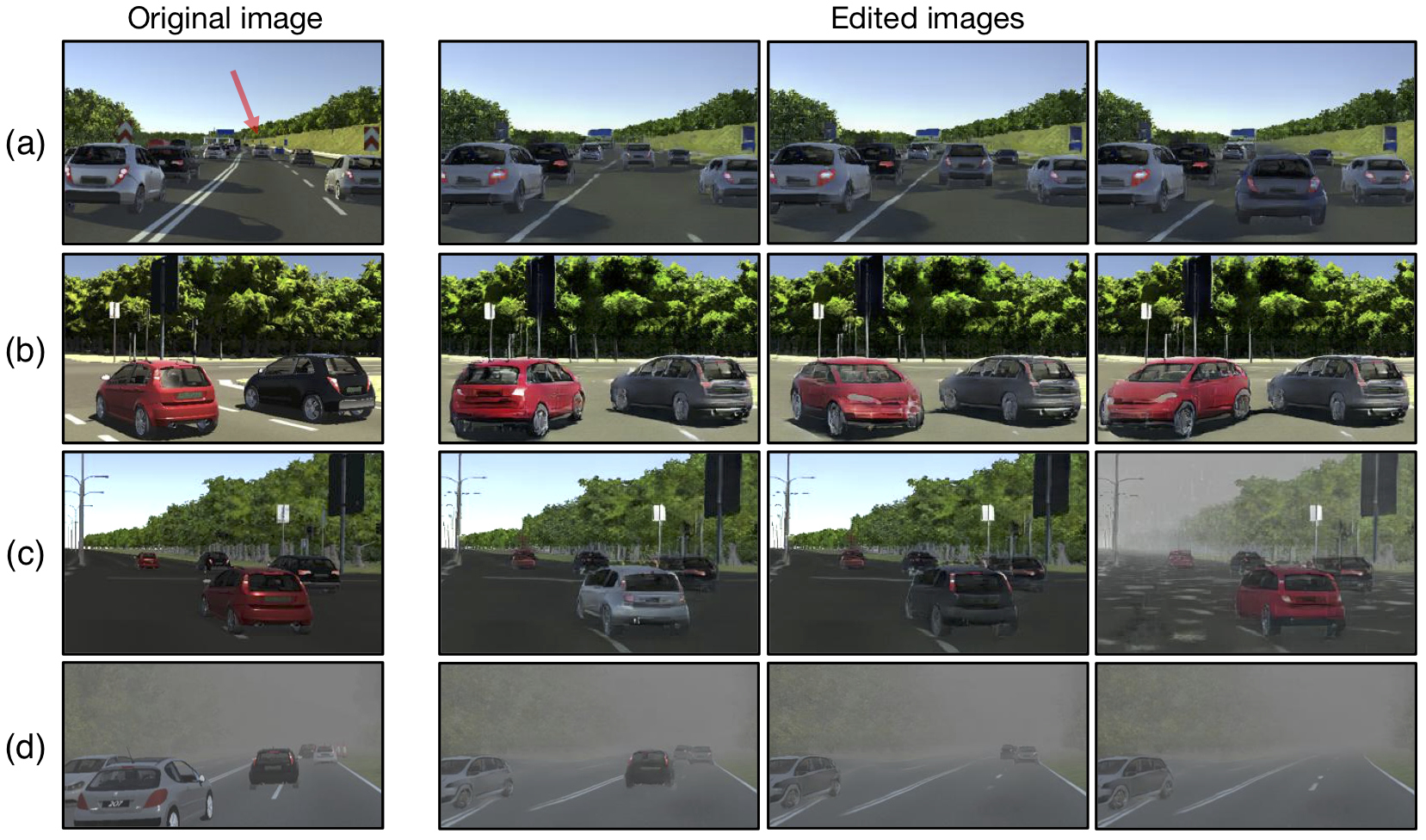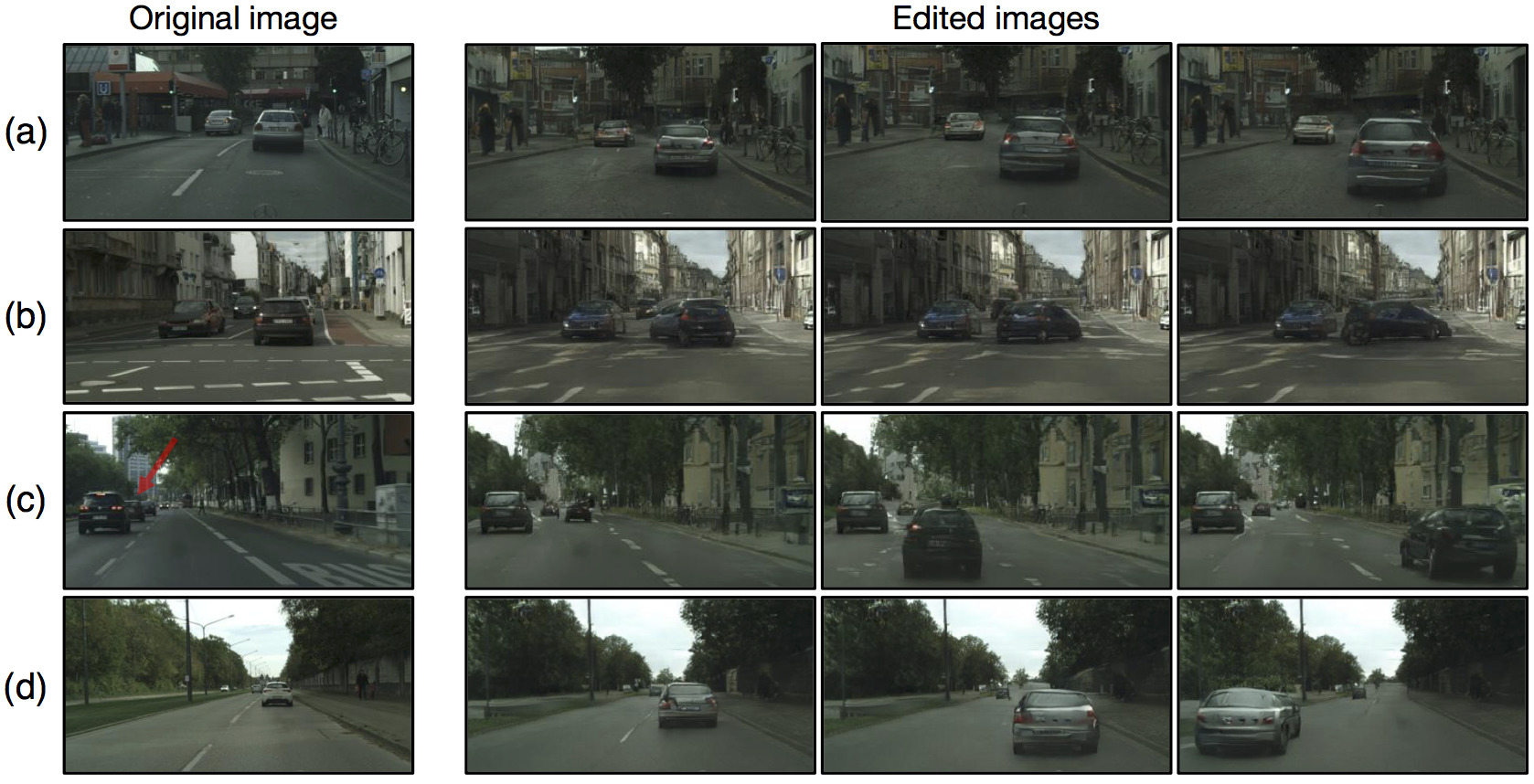PyTorch implementation for 3D-aware scene de-rendering and editing. Our method integrates disentangled representations for semantics, geometry, and appearance into a deep generative model. The disentanglement of semantics, geometry, and appearance supports 3D-aware scene manipulation such as (a) translation, (b) rotation, (c) color and texture editing, and (d) object removal and occlusion recovery.
3D-Aware Scene Manipulation via Inverse Graphics
Shunyu Yao*, Tzu-Ming Harry Hsu*, Jun-Yan Zhu, Jiajun Wu, Antonio Torralba, William T. Freeman, Joshua B. Tenenbaum
In Neural Information Processing Systems (NeurIPS) 2018.
MIT CSAIL, Tsinghua University, and Google Research.
Our de-renderer consists of a semantic-, a textural- and a geometric branch. The textural renderer and geometric renderer then learn to reconstruct the original image from the representations obtained by the de-renderer modules.
Example user editing results on Cityscapes.
(a) We move two cars closer to the camera.
(b) We rotate the car with different angles.
(c) We recover a tiny and occluded car and move it closer. Our model can synthesize the occluded region.
(d) We move a small car closer and then change its locations.
- Linux
- Python 3.6+
- PyTorch 0.4
- NVIDIA GPU (GPU memory > 8GB) + CUDA 9.0
-
Clone this repository
git clone https://github.com/ysymyth/3D-SDN.git && cd 3D-SDN
-
Download the pre-trained weights
./models/download_models.sh
-
Set up the conda environment
conda env create -f environment.yml && conda activate 3dsdn -
Compile dependencies in
geometric/maskrcnn./scripts/build.sh
-
Set up environment variables
source ./scripts/env.sh
We are using ./assets/0006_30-deg-right_00043.png as the example image for editing.
python semantic/vkitti_test.py \
--ckpt ./models \
--id vkitti-semantic \
--root_dataset ./assets \
--test_img 0006_30-deg-right_00043.png \
--result ./assets/example/semanticpython geometric/scripts/main.py \
--do test \
--dataset vkitti \
--mode extend \
--source maskrcnn \
--ckpt_dir ./models/vkitti-geometric-derender3d \
--maskrcnn_path ./models/vkitti-geometric-maskrcnn/mask_rcnn_vkitti_0100.pth \
--edit_json ./assets/vkitti_edit_example.json \
--input_file ./assets/0006_30-deg-right_00043.png \
--output_dir ./assets/example/geometricpython textural/edit_vkitti.py \
--name vkitti-textural \
--checkpoints_dir ./models \
--edit_dir ./assets/example/geometric/vkitti/maskrcnn/0006/30-deg-right \
--edit_source ./assets/0006_30-deg-right_00043.png \
--edit_num 5 \
--segm_precomputed_path ./assets/example/semantic/0006_30-deg-right_00043.png \
--results_dir ./assets/example \
--feat_pose True \
--feat_normal TrueThen the edit results can be viewed at ./assets/example/vkitti-textural_edit_edit_60/index.html.
Simply do cd ./assets/example/vkitti-textural_edit_edit_60 && python -m http.server 1234 and use your browser to connect to the server. You should see the results with intermediate 2.5D representations rendered as follows.
Please set up the datasets first and refer to semantic/README.md, geometric/README.md, and textural/README.md for training and testing details.
- Download the Virtual KITTI dataset.
./datasets/download_vkitti.shPlease cite their paper if you use their data.
Here is a fragment of our Virtual KITTI benchmark edit specification, in the form of a json file. For each edit pair, a source image would be world/topic/source.png and a target image would be world/topic/target.png. A list of operations is specified to transform the source image to the target image. Aligned with human cognition, each operation is either moving (modify) an object from a position to another, or delete it from our view. Additionally, we may enlarge (zoom) the object or rotate the object along the y-axis (ry). Note the y-axis points downwards, consistent with the axis specification of the Virtual KITTI dataset. The u's and v's denote the objects' 3D center projected onto the image plane. We indicate a target region of interest roi on top of the target (u, v) position. There are 92 such pairs in the benchmark.
{
"world": "0006",
"topic": "fog",
"source": "00055",
"target": "00050",
"operations": [
{
"type": "modify",
"from": {"u": "750.9", "v": "213.9"},
"to": {"u": "804.4", "v": "227.1", "roi": [194, 756, 269, 865]},
"zoom": "1.338",
"ry": "0.007"
}
]
}python semantic/vkitti_test.py \
--ckpt ./models \
--id vkitti-semantic \
--root_dataset ./datasets/vkitti \
--test_img benchmark \
--benchmark_json ./assets/vkitti_edit_benchmark.json \
--result ./assets/vkitti-benchmark/semanticpython geometric/scripts/main.py \
--do test \
--dataset vkitti \
--mode extend \
--source maskrcnn \
--ckpt_dir ./models/vkitti-geometric-derender3d \
--maskrcnn_path ./models/vkitti-geometric-maskrcnn/mask_rcnn_vkitti_0100.pth \
--output_dir ./assets/vkitti-benchmark/geometric \
--edit_json ./assets/vkitti_edit_benchmark.jsonpython textural/edit_benchmark.py \
--name vkitti-textural \
--checkpoints_dir ./models \
--dataroot ./datasets/vkitti \
--edit_dir ./assets/vkitti-benchmark/geometric/vkitti/maskrcnn \
--edit_list ./assets/vkitti_edit_benchmark.json \
--experiment_name benchmark_3D \
--segm_precomputed_path ./assets/vkitti-benchmark/semantic \
--results_dir ./assets/vkitti-benchmark/ \
--feat_pose True \
--feat_normal TrueThen the benchmark edit results can be viewed at ./assets/vkitti-benchmark/vkitti-textural_benchmark_3D_edit_60/index.html.
If you find this useful for your research, please cite the following paper.
@inproceedings{3dsdn2018,
title={3D-Aware Scene Manipulation via Inverse Graphics},
author={Yao, Shunyu and Hsu, Tzu Ming Harry and Zhu, Jun-Yan and Wu, Jiajun and Torralba, Antonio and Freeman, William T. and Tenenbaum, Joshua B.},
booktitle={Advances in Neural Information Processing Systems},
year={2018}
}
For any question, please contact Shunyu Yao and Tzu-Ming Harry Hsu.
This work is supported by NSF #1231216, NSF #1524817, ONR MURI N00014-16-1-2007, Toyota Research Institute, and Facebook.
The semantic branch borrows from Semantic Segmentation on MIT ADE20K dataset in PyTorch, the geometric branch borrows from pytorch-mask-rcnn and neural_renderer, and the textural branch borrows from pix2pixHD.




